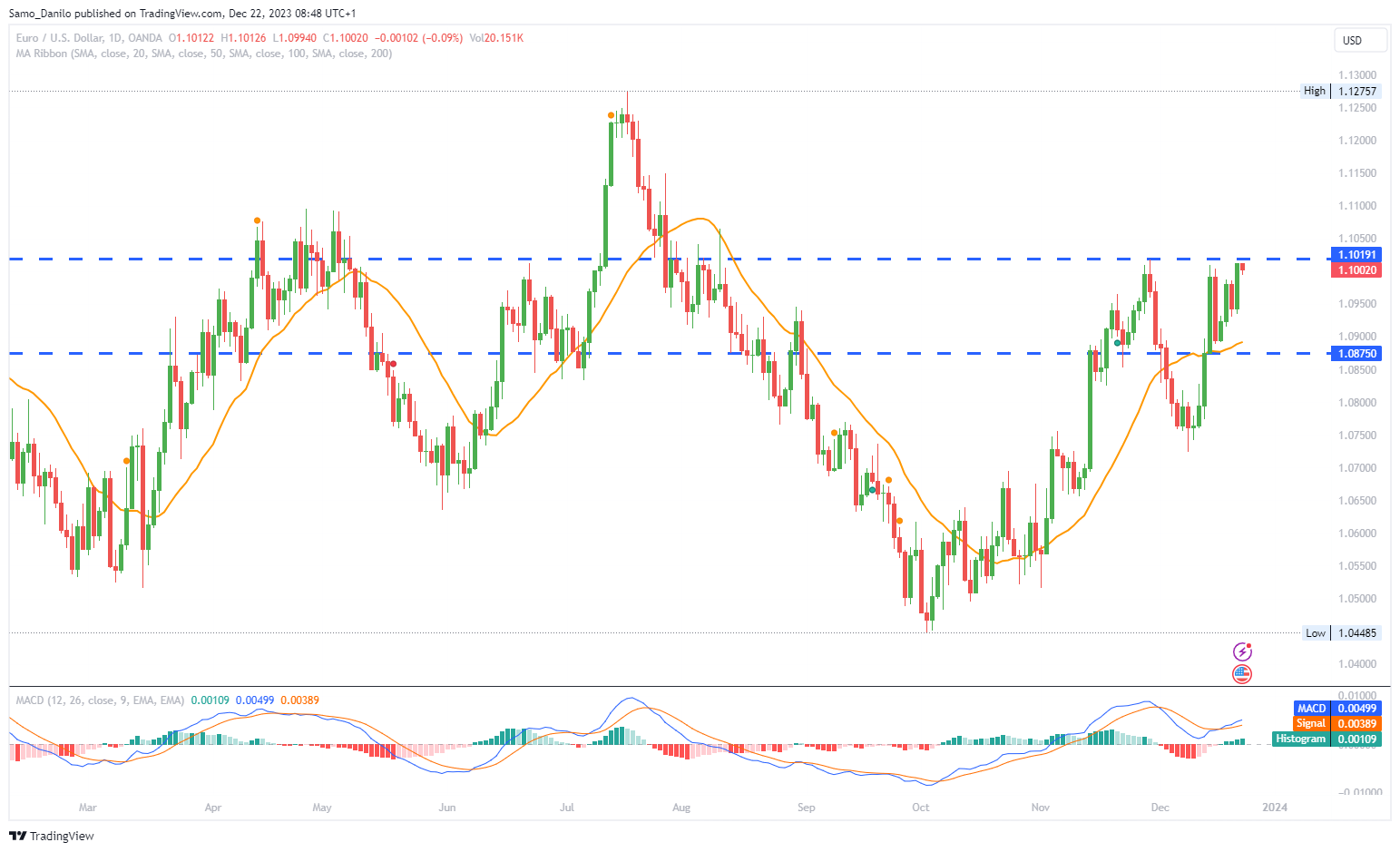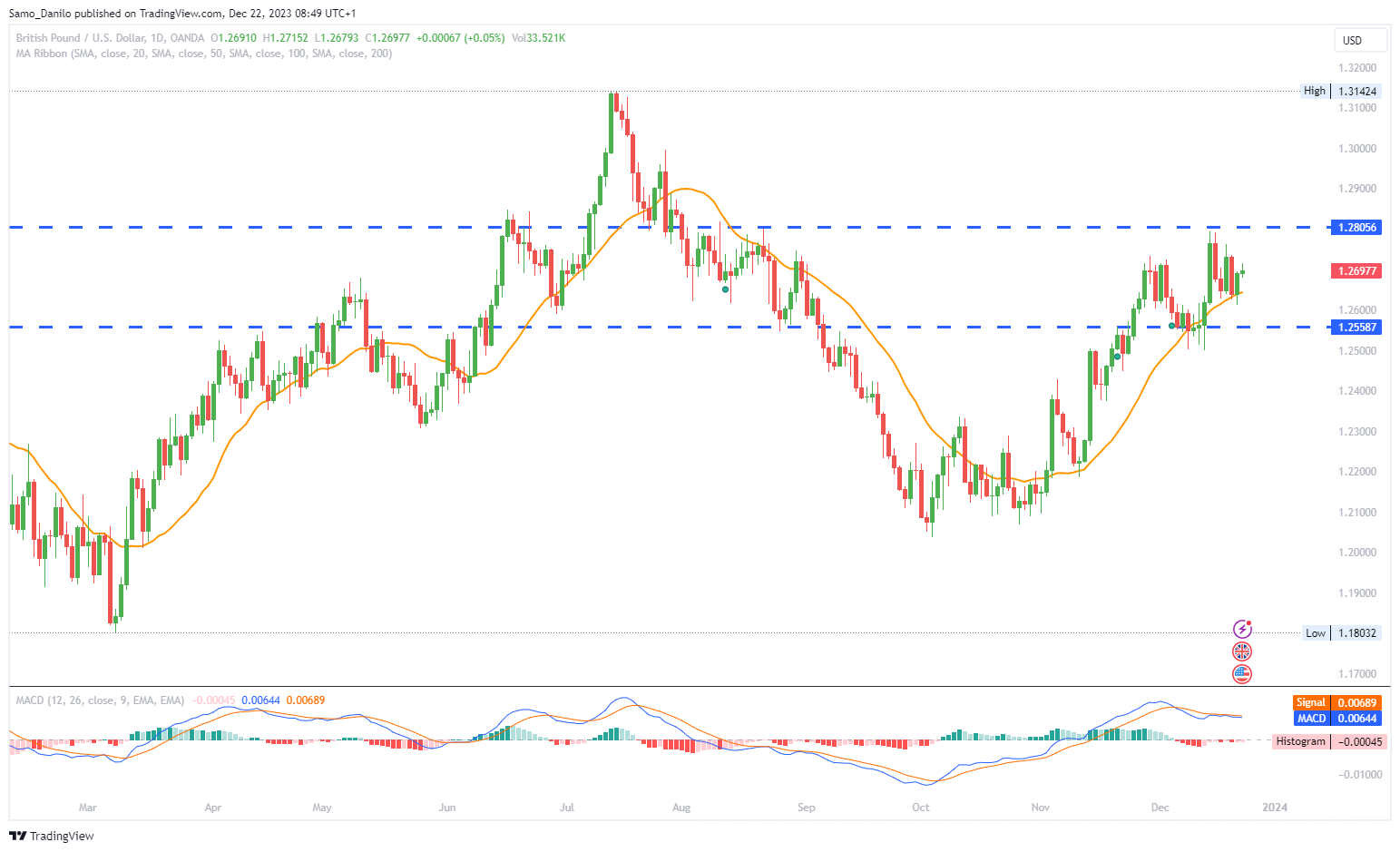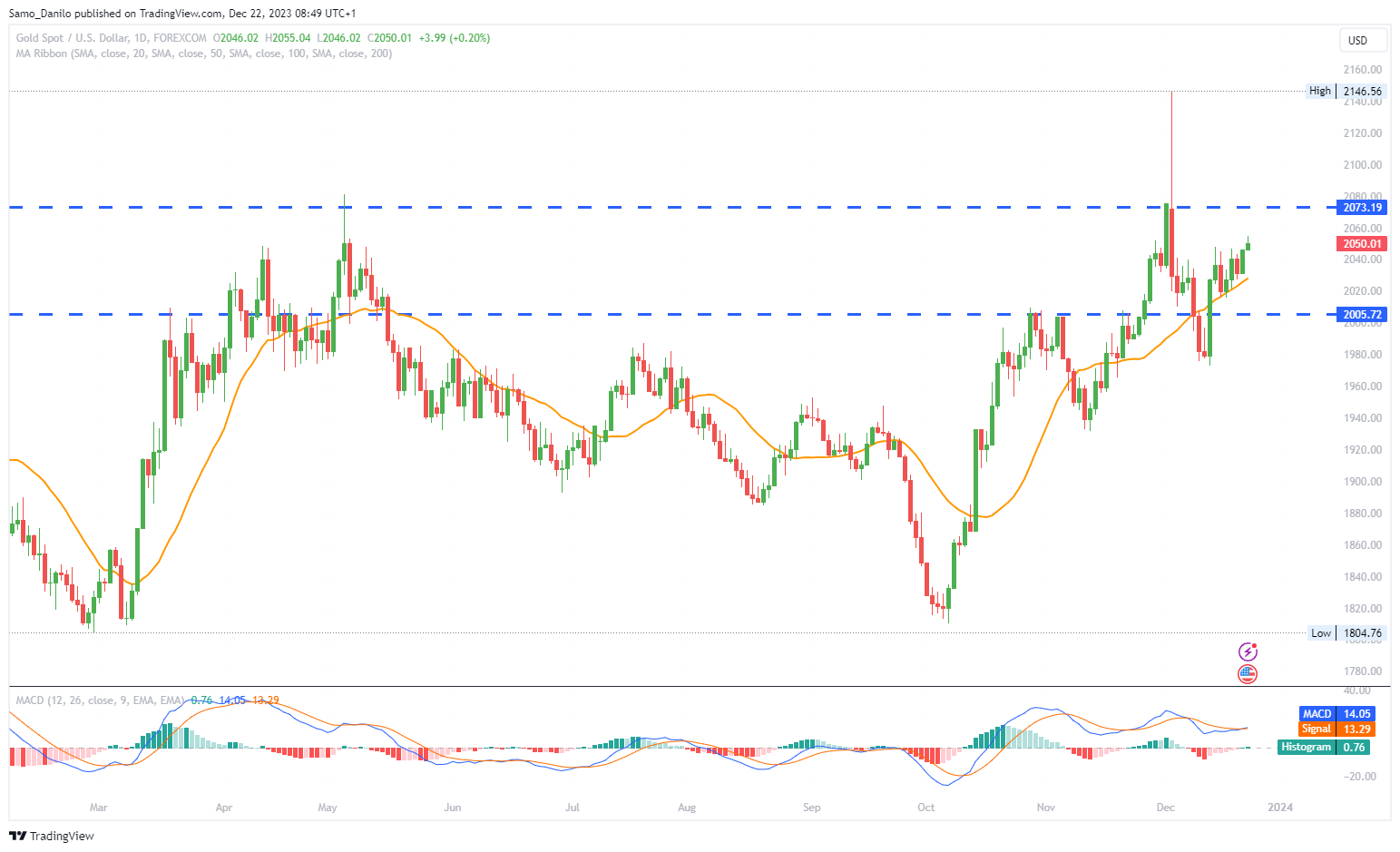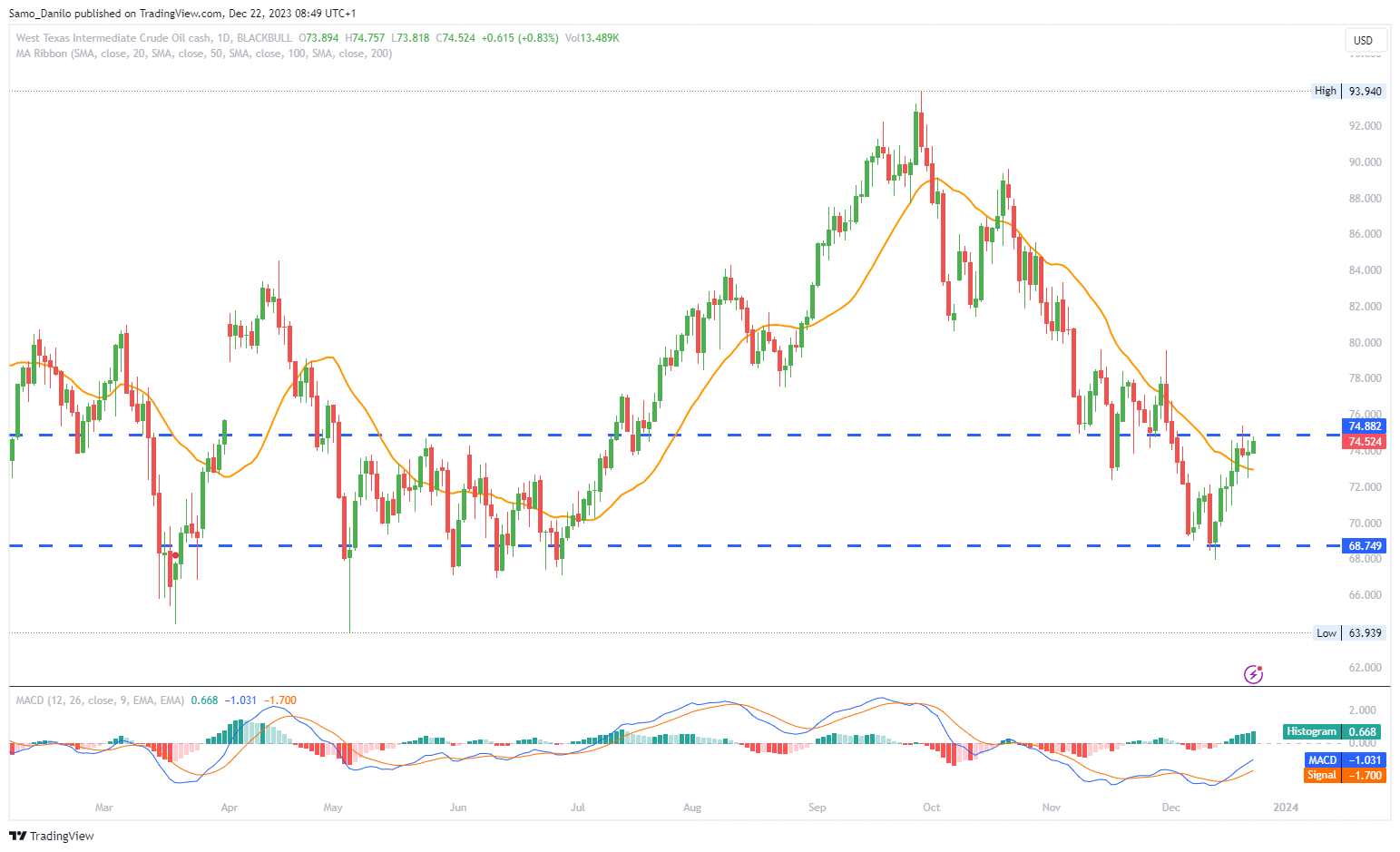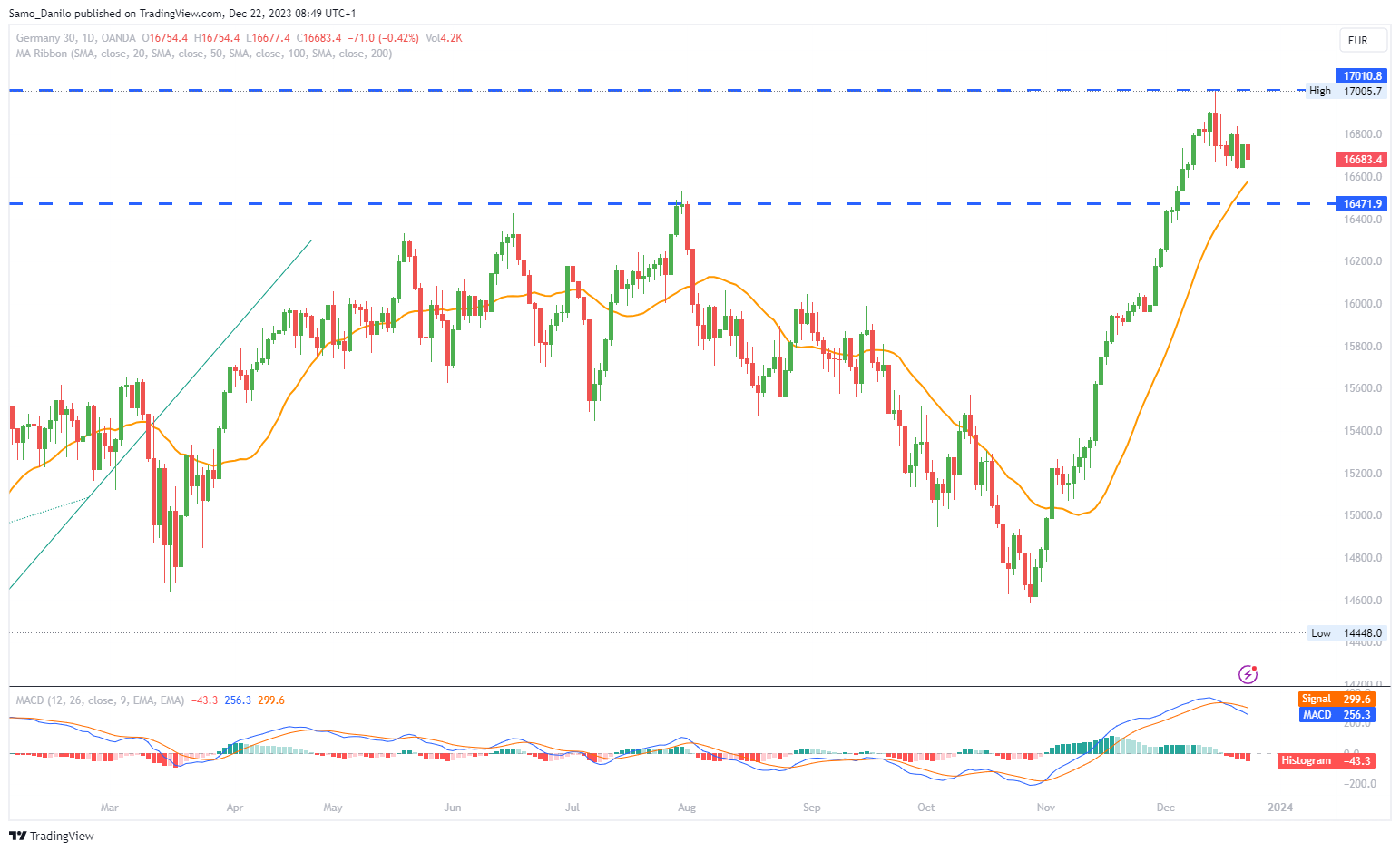EURUSD
- The EUR/USD pair is hovering below the psychological resistance at the 1.1000 level. It recently pulled back from a three-week high at 1.1012. The pair's movements are crucially influenced by the ongoing dynamics between the Euro and the US Dollar.
- Data from the US showed a decline in the Philadelphia Fed Index, signaling potential challenges in the regional manufacturing sector. Additionally, there was a downward revision to Q3 GDP from 5.2% to 4.9%. Jobless Claims showed little change from the previous week, reflecting a stable but closely monitored labor market.
- On Friday, the focus turns to the release of the Core Personal Consumption Expenditure Price Index (Core PCE), which is the Federal Reserve's preferred inflation gauge. Analysts expect a 0.2% increase for November. Inflation figures are closely scrutinized as they can have a significant impact on monetary policy decisions.
- The US Dollar remains under pressure despite a rebound in US yields. The EUR/USD pair is benefiting from a weaker US Dollar, but the upside potential may be limited, especially considering the thinned market conditions during certain periods.
Closing statement: EUR/USD is navigating below a key psychological level, and upcoming US inflation data is awaited for further market direction. The pair's movements are intertwined with the dynamics of the US Dollar, and traders are carefully assessing economic indicators for potential shifts in sentiment.
GBPUSD
- The GBP/USD pair continues to fluctuate within a narrow channel around the 1.2700 level in the European morning on Friday. The pair's movements are reflective of the ongoing dynamics between the British Pound (GBP) and the US Dollar (USD).
- Market positioning has shifted, anticipating a potential Bank of England (BoE) policy pivot, particularly after the UK Consumer Price Index (CPI) readings for November came in below analysts' forecasts earlier in the week.
- Goldman Sachs has revised its forecast, now expecting a 25-basis points rate cut in May, compared to June, influenced by the inflation data.
- Retail Sales in the UK showed a positive trend, rising by 1.3% on a monthly basis in November, according to the UK's Office for National Statistics (ONS). This data point provides insights into consumer spending patterns and economic activity.
- The ONS announced that the annualized Gross Domestic Product (GDP) growth for the third quarter was revised lower to 0.3% from the initial estimate of 0.6%. This revision may influence perceptions of the economic landscape in the UK.
| SMA (20) | Rising |
|
|
| RSI (14) | Slightly Falling |
|
|
| MACD (12, 26, 9) | Slightly Falling |
|
Closing statement: GBP/USD is navigating within a narrow range, influenced by shifting expectations regarding the Bank of England's policy stance. The pair is responsive to economic data, and recent figures, including retail sales and GDP growth, are shaping market sentiment. Traders are closely monitoring these developments for potential trading opportunities.
GOLD
- Gold price is encountering challenges as it attempts to capitalize on its intraday uptick, hovering just below the $2,050 level. The precious metal has recently reached a near three-week high, and its current movements are under scrutiny as traders assess various factors.
- The US Dollar has changed its course, with its direction influenced by mixed economic data from the United States. Initial Jobless Claims for the week ending December 15 showed improvement, sliding to 205K, better than the expected 215K.
- However, the Q3 US Gross Domestic Product (GDP) confirmed a growth rate of 4.9%, slightly below the preliminary estimate of 5.2%.
- Market attention is shifting to the upcoming release of the US Core Personal Consumption Expenditures (PCE) Price Index, scheduled for Friday. The annual reading is anticipated to be 3.3% in November, indicating a slight easing from the 3.5% recorded in the previous month. This index is closely watched as a key measure of inflation by the Federal Reserve.
- In addition to the Core PCE Price Index, the US is set to publish November Durable Goods data and the final estimate of the December Michigan Consumer Sentiment Index. These indicators contribute to the broader economic assessment and can impact market sentiment.
| SMA (20) | Rising |
|
|
| RSI (14) | Slightly Falling |
| |
| MACD (12, 26, 9) | Slightly Falling |
|
Closing statement: Gold is navigating around the $2,050 level amid mixed signals from the US, including positive jobless claims data and slightly lower-than-expected GDP growth. Traders are awaiting the release of the Core PCE Price Index for further insights into inflation trends, along with other economic indicators that could shape the direction of gold prices in the short term.
CRUDE OIL
- West Texas Intermediate (WTI) crude oil price is trading higher, reaching around $74.50 per barrel, marking the second consecutive day of gains. The current uptrend is noteworthy for market participants as they assess various factors influencing oil prices.
- The decision by several shipping companies, including Germany's Hapag-Lloyd and Hong Kong's OOCL, to avoid the Suez Canal is indicative of escalating concerns in the Red Sea. This region has witnessed geopolitical disruptions, particularly with attacks by the Iran-led Houthi militant group on commercial vessels.
- Angola's recent decision to exit the Organization of the Petroleum Exporting Countries and its allies (OPEC+) adds a new dimension to the evolving geopolitical landscape in the oil market. Angola's Oil Minister, Diamantino Azevedo, emphasized that the country's interests were not adequately served within the group.
- Angola's departure aligns it with other mid-sized producers like Ecuador and Qatar, which have also exited the OPEC+ group over the past decade. These strategic shifts among oil-producing nations can impact production dynamics and influence global oil prices.
- Market participants are anticipating the release of Baker Hughes' US Oil Rig Count data on Friday. This report provides insights into business conditions in the drilling industry and can offer fresh impetus to oil prices.
| SMA (20) | Falling |
|
|
| RSI (14) | Rising |
|
|
| MACD (12, 26, 9) | Rising |
|
|
Closing statement: WTI crude oil is on an upward trajectory, supported by geopolitical concerns in the Red Sea and Angola's decision to exit OPEC+. As market participants await the Baker Hughes US Oil Rig Count data, the evolving geopolitical landscape and global demand dynamics continue to shape the outlook for crude oil prices.
DAX
- On Thursday, buyer demand for DAX-listed stocks was impacted by commentary from the European Central Bank (ECB) officials. ECB Executive Board members, including Luis de Guindos, poured cold water on expectations of a rate cut in the first half of 2024, emphasizing that it was too early to discuss interest rate cuts.
- There were no German or Eurozone economic indicators released on Thursday, leaving investors to react primarily to central bank commentary and global market dynamics.
- Positive support for the DAX came from economic indicators in the United States on Thursday. The Philly Fed Manufacturing Index and Q3 GDP numbers contributed to the market sentiment, supporting expectations of a potential rate cut by the Federal Reserve in Q1 2024.
- On Friday, investors are closely watching US personal income/spending and the Core Personal Consumption Expenditure (PCE) Price Index. These indicators will provide insights into the health of the US economy and could influence market sentiment regarding the timing of potential Fed rate adjustments.
- Beyond economic indicators, market participants need to consider central bank commentary, particularly from the Federal Reserve. Comments from Fed officials in response to the US economic data will be crucial in shaping expectations about the future trajectory of interest rates.
| SMA (20) | Rising |
|
|
| RSI (14) | Falling |
|
|
| MACD (12, 26, 9) | Slightly Falling |
|
Closing statement: The DAX saw some impact from ECB commentary, but positive support from US economic indicators countered some of the effects. As investors await US personal income/spending and Core PCE Price Index data, the interplay between global economic indicators and central bank commentary continues to shape the direction of the DAX.
